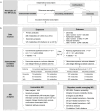Causal Association between Circulating Metabolites and Dementia: A Mendelian Randomization Study
- PMID: 39275195
- PMCID: PMC11397200
- DOI: 10.3390/nu16172879
Causal Association between Circulating Metabolites and Dementia: A Mendelian Randomization Study
Abstract
The causal association of circulating metabolites with dementia remains uncertain. We assessed the causal association of circulating metabolites with dementia utilizing Mendelian randomization (MR) methods. We performed univariable MR analysis to evaluate the associations of 486 metabolites with dementia, Alzheimer's disease (AD), and vascular dementia (VaD) risk. For secondary validation, we replicated the analyses using an additional dataset with 123 metabolites. We observed 118 metabolites relevant to the risk of dementia, 59 of which were lipids, supporting the crucial role of lipids in dementia pathogenesis. After Bonferroni adjustment, we identified nine traits of HDL particles as potential causal mediators of dementia. Regarding dementia subtypes, protective effects were observed for epiandrosterone sulfate on AD (OR = 0.60, 95% CI: 0.48-0.75) and glycoproteins on VaD (OR = 0.89, 95% CI: 0.83-0.95). Bayesian model averaging MR (MR-BMA) analysis was further conducted to prioritize the predominant metabolites for dementia risk, which highlighted the mean diameter of HDL particles and the concentration of very large HDL particles as the predominant protective factors against dementia. Moreover, pathway analysis identified 17 significant and 2 shared metabolic pathways. These findings provide support for the identification of promising predictive biomarkers and therapeutic targets for dementia.
Keywords: Alzheimer’s disease; Mendelian randomization; dementia; metabolites; vascular dementia.
Conflict of interest statement
The authors declare no competing interests.
Figures




References
MeSH terms
Substances
Grants and funding
LinkOut - more resources
Full Text Sources
Medical

